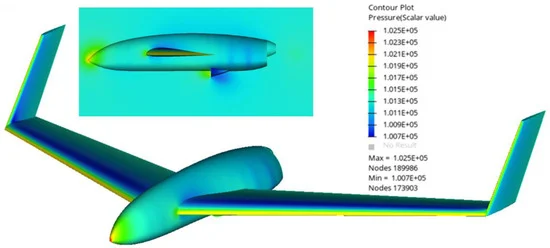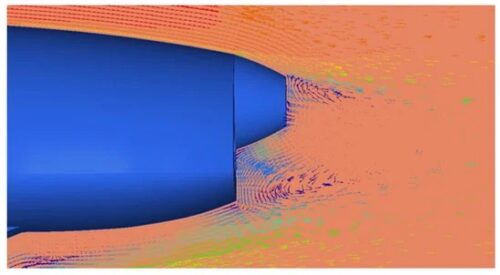The Right Stuff: Manufacturing a UAV Sandwich
Making AAM Magic Using Composite Materials

Stay tuned: We are changing our name to AAM Today (aam.today) in the weeks ahead.
[Feature image above] Pressure distribution on the UAV (Image copyright and courtesy of Department of Mechanical and Aeronautical Engineering, University of Patras and Software & Knowledge Engineering Lab, Institute of Informatics and Telecommunications, National Centre for Scientific Research)
When it’s a tailless type-C composite sandwich uncrewed aerial vehicle (UAV) you’re out to design and manufacture, the weight restrictions — the entire vehicle must weigh less than 25 kg (about 55 lbs) — you face a significant challenge: the mass of the structure must be less than 9 kg (about 19.4 lbs).
Writing in Aerospace 2024, Cristoforos S. Rekatsinas, Dimitris K. Dimitriou, and Nikolaos A. Chrysochoidis, researchers at University of Patras, Rion, Greece, and Institute of Informatics and Telecommunications, National Centre for Scientific Research “Demokritos,” explain that using carbon-fiber reinforced materials in a sandwich configuration will be essential for successful manufacturing and operations of UAVs. The trio have mapped out a method to optimize such composite UAVs.
Critically, they suggest:
- “The number of holes should be limited, as drilling down the composite aerostructure would conclude to the generation of delaminations.”
- The joints between sections with different thicknesses could lead to stress concentrations and disbands.
Rekatsinas, Dimitriou, and Chrysochoidis considered dynamic loading, such as gusts and shock loads. The design was tested under 3g acceleration in all three directions—“a 750 N load in every direction, and 90 kPa pressure on top of the entire aircraft, for a velocity magnitude of 33 m/s.” They believe their methods are flexible, adaptable, and environmentally friendly.
They laid out a roadmap an optimized UAV design protocol as follows:
- Aerodynamic analysis for the estimation of loads.
- Topology optimization to determine the material paths of the initial design.
- Free-size optimization to obtain the first estimation of the thicknesses of each material configuration.
- Size/Composite optimization to fully determine the thicknesses and lay-ups of each material region.
- Static and stress analysis to ensure the safe and successful UAV design.
Bulletproof and featherweight
Halfway around the world, writing in the March 2024 issue of the Journal of the Brazilian Society of Mechanical Sciences and Engineering, Sarvesh Sonkar, Prashant Kumar, Riya Catherine George, T.P. Yuvaraj, Deepu Philip, and A.K. Ghosh detailed their study on which composite materials were optimal to build a lightweight, low-altitude long endurance (LALE) hybrid VTOL UAV. Their experiment included carbon fiber, Kevlar, fiber-reinforced plastic (FRP), and resins.

Velocity streamlines at the rear of the UAV. (Image copyright and courtesy of Sarvesh Sonkar, Prashant Kumar, Riya Catherine George, T.P. Yuvaraj, Deepu Philip, and A.K. Ghosh
They formed 10 different grades of carbon fiber, FRP, and resins sized to 120mm x 5mm using vacuum bagging which they then cured and, using a universal testing machine (UTM), quantified their dynamic mechanical characteristics under various bending loads. They were aiming for those combinations that would produce maximum strength with minimal weight. To test their results, they manufactured a UAV prototype and flight-tested it.
So, where did all this time in the lab and out in the field take them? They settled on two layers of 93 GSM combined with one layer of 2 GSM carbon fiber (CF93-CF2-CF93-R0) in a sandwich manner to provide an optimal combination for manufacturing the hybrid UAV, achieving the desired payload-to-weight ratio, resulting in a total airframe weight of around 2.7 kg with a maximum take-off weight (MTOW) of about 12 kg.
I’ll have a Kevlar on carbon fiber, easy on the holes.
These studies coming out of Brazil and Greece propel the science of advanced air mobility a few steps closer to real-world applications and certification of UAVs. There’s still work to be done, but it’s being done. It will get done. And, we will all benefit from it.

Stay up-to-date with the latest urban air mobility, advanced air mobility, and eVTOL news? Subscribe to AeroCar Journal today. It’s free for a limited time!


